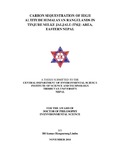Please use this identifier to cite or link to this item:
http://archive.nnl.gov.np:8080/handle/123456789/221| Title: | CARBON SEQUESTRATION OF HIGH ALTITUDE HIMALAYAN RANGELANDS IN TINJURE MILKE JALJALE (TMJ) AREA, EASTERN NEPAL |
| Authors: | Dil Kumar Hangsurung Limbu, Dil Kumar |
| Keywords: | Soil |
| Issue Date: | 27-Mar-2019 |
| Abstract: | Grazing is one of the most important activities influencing the biomass and structure in a natural grassland ecosystem. Different grazing intensities also have the potential to alter soil C and N storage as well as microbial biomass substantially in grasslands. The objective of this study is to identify and quantify the present status of carbon and nitrogen pool in Himalayan rangeland and to make recommendations for enhancing carbon and nitrogen storage for rangeland management. To meet the aforementioned goals, the field study was conducted in 2011 - 2013. Three experiments were carried out viz; heavily grazed, occasional grazed and ungrazed plots. Each plot was further divided into legume seeding and non-legume sub-plots. At the end of the three years continuous grazing experiment (late September 2013), sampling points were established in two parallel transect lines in each subplots. A quadrat (30 cm × 30 cm) was laid down at each sampling point. From each quadrat, soil samples were collected with the help of soil core having 4 cm diameter and 15 cm length to obtain three separate sections viz. 0–5 cm, 5-10 cm and 10–15 cm slice. The soil sample was oven dried at 100°C to a constant weight. From the processed samples, Soil Bulk Density (SBD), Soil Organic Carbon (SOC), Total Nitrogen (TN), Soil Microbial Biomass Carbon (SMBC), and Soil Microbial Biomass Nitrogen (SMBN) were determined by standard methods. Above Ground Biomass (AGB) was collected by total harvesting method. For collection of Below Ground Biomass (BGB), the assigned quadrat was excavated up to 15 cm depth and the whole excavated soil with BGB was washed with water jet in a 2 mm sieve. The collected biomass was oven-dried at 70o C to obtain a constant weight. In fact, above ground biomass and below ground biomass were separated and analyzed by the process of washing, sieving and hand picking method. |
| URI: | http://103.69.125.248:8080/xmlui/handle/123456789/221 |
| Appears in Collections: | 300 Social sciences |
Files in This Item:
| File | Description | Size | Format | |
|---|---|---|---|---|
| Ph D Thesis Dil Kumar Limbu.pdf | 4.32 MB | Adobe PDF |  View/Open |
Items in DSpace are protected by copyright, with all rights reserved, unless otherwise indicated.